Jewish Motol: Genealogical and Family History Bibliography
Jewish Motol: Genealogical and Family History Bibliography
Jewish Motol: Genealogical and Family History Bibliography
You also want an ePaper? Increase the reach of your titles
YUMPU automatically turns print PDFs into web optimized ePapers that Google loves.
<strong>Jewish</strong> <strong>Motol</strong>:<br />
<strong>Genealogical</strong> <strong>and</strong> <strong>Family</strong> <strong>History</strong> <strong>Bibliography</strong><br />
For my gr<strong>and</strong>mother<br />
Hayah Fruma Epstein<br />
Born 1874 in Motele<br />
Died October 1942 at Dobrovolie near Pinsk<br />
Itzhak Epstein<br />
May 13, 2003<br />
This bibliography’s primary purpose is to identify the written resources available to genealogists<br />
<strong>and</strong> family historians researching the Jews who lived in <strong>Motol</strong>, or Motele as it was called by our<br />
ancestors, between its annexation by Russia from Pol<strong>and</strong> in 1795 <strong>and</strong> the annihilation of its Jews<br />
on August 2 nd <strong>and</strong> 3 rd 1941. It is not intended to provide general information about genealogy <strong>and</strong><br />
<strong>Jewish</strong> history. Nor, with the exception of one cluster of families, is it intended to deal with<br />
specific Motele family histories. While I have read some of the bibliography’s entries fully, I<br />
only browsed through others.<br />
Comments, corrections <strong>and</strong> suggested additions are welcome.<br />
Itzhak Epstein<br />
P.O. Box 20128<br />
New York, NY 10025<br />
USA<br />
Itzhak.epstein@earthlink.net<br />
1
I -- THE JEWS OF RUSSIA AND POLAND<br />
Only a few books, all in English, are listed. There are obviously many additional worthwhile<br />
sources<br />
1. Baron, Salo W. The Russian Jew Under Tsars <strong>and</strong> Soviets: A comprehensive history<br />
from the earliest settlements to the present time. New York: Macmillan, 1964. 415 pages.<br />
Until page 200 the book deals with Tsarist Russia. Still the basic text on the subject.<br />
2. Zborowski, Mark <strong>and</strong> Herzog, Elizabeth. Life Is With People: The Culture of the Shtetle.<br />
New York: Schoken Books (paperback), 1962. 452 pages.<br />
The 1952 classic from the anthropological point of view.<br />
3. Wischnitzer, Mark. To Dwell in Safety; the story of <strong>Jewish</strong> migration since 1800.<br />
Philadelphia: <strong>Jewish</strong> Publication Society of America, 1948. 368 pages.<br />
Why <strong>and</strong> how they got from there to elsewhere.<br />
4. Marcus, Joseph. Social <strong>and</strong> political <strong>History</strong> of the Jews in Pol<strong>and</strong>, 1919 - 1939. Berlin:<br />
Mouton Publishers, 1983. 569 pages.<br />
The best English language comprehensive book on Polish Jewry in the inter-war years<br />
that I saw.<br />
2
II -- POLESIE<br />
Polesie has been defined in several ways. It is often synonymous with the Prypiet Marshes. The<br />
broadest definition is that of a trapezoid whose larger base is formed by the Kiev-Mogilev line<br />
<strong>and</strong> its parallel smaller base consists of about 110 km (or 70 Miles) along the Bug around Brest.<br />
Motele researchers are mostly interested in the northwestern part of greater Polesie. Even the<br />
few listed sources do not provide an adequate underst<strong>and</strong>ing of how the Jews of <strong>Motol</strong> related to<br />
the communities around them. As one progresses with her/his genealogical research he/she<br />
discovers how our ancestral families ranged all over the western Prypiet marshes <strong>and</strong> somewhat<br />
even as far north as Slonim <strong>and</strong> Volkovysk.<br />
<strong>Motol</strong>, 52'’ 19' N 25'’ 36' E, was in the Kobryn Uezd (district) of Grodno Gubernia (province)<br />
until the collapse of the Russian empire in 1917. Between WWI <strong>and</strong> WWII it was in the<br />
Drohiczyn district of th Polish the Gubernia of Polesie. It is near the center of Polish Polesie<br />
which constituted an irregular rectangle of roughly 110 miles from east to west <strong>and</strong> 50 miles<br />
from north to south. While <strong>Motol</strong>’s <strong>Jewish</strong> community gained its independence from Pinsk’s in<br />
the 1760s it continued to relate to Pinsk as its central city. The Jews of the villages <strong>and</strong> estates<br />
near <strong>Motol</strong> often related to <strong>Motol</strong> as their central community. However, such yishuvukim might<br />
have also related to a neighboring shtetle; such as Yaneve (Ivanovo) to the south, Homsk to the<br />
west, Lohishin to the east or Telhan to the north.<br />
6. Hoffman, B. (editor). Toiznt Yohr Pinsk [The Thous<strong>and</strong> Years of Pinsk]. New York:<br />
Pinsk Branch 210 of the Workmen’s Circle, 1941. 497 pages.<br />
Yiddish. Especially useful are pages 287 - 297 which deal with an overview of Polesie.<br />
7. Levin, Yosef. Antopol: Mitoldoteha shel kehilla ahat bepolesiyah [Antopol: From the<br />
history of a <strong>Jewish</strong> community in Polesie]. Tel Aviv: self published , 1967. 164 pages.<br />
Hebrew. Contains an essay on Polesie (pages 20 - 35) that uses much of the TYP article<br />
above. Sometimes opinionated but readable by those who know Hebrew but not Yiddish.<br />
8. Spector, Shmuel. Pinkas Hakehilot: Encyclopedia of <strong>Jewish</strong> Communities: Pol<strong>and</strong>, Vol.<br />
V: Volhynia <strong>and</strong> Polesie. Jerusalem: Yad Vashem, 1990. 341 pages.<br />
Hebrew. pages 209 - 218 deal with the Jews of Polesie.<br />
9. Rabinowitsch, Wolf Zev. Lithuanian Hasidism. Translated from Hebrew by M.B. Dagut.<br />
London: Valentine Mitchell, 1970. 263 pages.<br />
The best available source about the Weingartens <strong>and</strong> Hasidism in Polesie.<br />
3
III -- MOTOL MEMOIRS<br />
These writings provide a glimpse of how our ancestors lived. Some of these memoirs dealt<br />
mostly with daily life in Motele. Genealogy, if at all, was a minor concern of the writers. While<br />
they described families <strong>and</strong> individuals, they were often vague about how the actual relationships<br />
were formed. Some of these writings provide rich information about specific families. Most of<br />
the literature relates to the Chemerinsky/Chemerinsky/Fialkov/Weingarten/Weizmann/Shapiro<br />
group of families. Though memoirs by members of <strong>Motol</strong>’s leading families are available, we<br />
know little about life from the perspective of its poorer Jews.<br />
10. Chemerinsky, Hayim (Reb Mordechele). Ayarati Motele [Motele My Shtetle]. Edited by<br />
Alter Druyanov with advice from Hayim Fialkov . Glossary by Yom Tov Levinsky. Tel Aviv:<br />
Dvir, 1951. (First appeared in Reshumot Vol II, 1927 pages 5-124.) 209 pages.<br />
Hebrew. This 1917 deathbed classic provides an excellent description of <strong>Jewish</strong> <strong>Motol</strong> of<br />
about 1865 - 1880. It also provides some background about earlier decades <strong>and</strong><br />
impressions of how <strong>Motol</strong> changed by the early 20 th century. The author describes his<br />
own family’s immediate genealogy in some detail. He also describes several dozen<br />
individuals. Unfortunately, many names were altered by the editor. I have been told that<br />
a new edition was published recently.<br />
A new Hebrew edition of Ayarati Motele was published in 2002 by the Hebrew<br />
University Magnes Press with a forward by Dr. David Assaf.<br />
A reasonable attempt to translate the book into English can be found at the YIVO Library<br />
in New York. It seems to be a photocopy of a word-processed document. I am trying to<br />
obtain an electronic version.<br />
11. Weizmann-Lichtenstein, Hayah. Betzel Korateinu: Pirkei zichronot mibeit abba [Under<br />
Our Roof: Memoirs from my father’s house]. Tel Aviv: Am Oved, 1948. 258 pages.<br />
Hebrew. More autobiographical then Ayarati Motele by Reb Mordechele’s first cousin<br />
once removed. Her version of some accounts sometimes differs with Chemerinsky’s. The<br />
first 75 pages take place in <strong>Motol</strong>. 1880 -1895.<br />
12. Weizmann, Chaim. Trial <strong>and</strong> Error. Harper & Brothers: New York, 1949. 498 pages.<br />
The autobiography of a very public person <strong>and</strong> the foremost <strong>Jewish</strong> leader of the first half<br />
of the 20 th Century -- Lichtenstein’s brother who left for school in Pinsk in the mid 1880s<br />
<strong>and</strong> by page 16 of the book. Not everything he writes about his childhood should be<br />
taken literally.<br />
4
13. Weizmann, Rahel Leah (as told to Jean Jaffe). “Mamme Veitzman” [Weizmann’s<br />
Mother]. Der Tog. (Serialized.) April-May 1938.<br />
Yiddish. Chaim <strong>and</strong> Hayah’s mother’s version of what her children would recount in<br />
their autobiographies around a decade later. Jaffe seems to have recycled some of the<br />
contents in Hebrew <strong>and</strong> English elsewhere (see below).<br />
14. Yarden, Shmuel. Sipurah shel Motele [Motele’s Story]. Bnei Brak: Self published,<br />
1978? 200 pages.<br />
Hebrew. Memoirs from the late 1920s - early 1930s when the author was less than 10<br />
years old. Might have been aided by his family. The book provides a useful update of<br />
Ayarati Motele’s communal description. It deals in some detail with the author’s<br />
immediate family. However, it contains very little genealogical information.<br />
5
IV -- THE SHOAH<br />
15. Klavan, Avraham. “<strong>Motol</strong>”. In Pinkas Hakehilot (see above under Polesie).<br />
pages 267 - 268 provide a very short outline of <strong>Jewish</strong> <strong>Motol</strong>’s history <strong>and</strong> end.<br />
16. Hurban Motele/The Destruction of Motele:<br />
Telling the tale of the writing, translation, production <strong>and</strong> distribution of this account of <strong>Jewish</strong><br />
Motele’s tragic end requires Reb. Mordechele’s sensibilities. Alas, what can be made out of<br />
this account was left to me to outline.<br />
16.1. The book was written in Yiddish by Aharon Leib Polik of Motele <strong>and</strong> Los Angeles, or<br />
Aaron Paul as he was known in America. According to Steve Kerlin he died in the 1990s. The<br />
Yiddish original, so it seems, was never published.<br />
16.2. In 1956 an English translation was published in mimeograph form. Its title page says:<br />
A.L. Polik (in English <strong>and</strong> Hebrew)<br />
HURBAN MOTELE (in Hebrew)<br />
THE DESTRUCTION OF MOTELE<br />
Translated from Yiddish to Hebrew <strong>and</strong> adapted by<br />
SZYMON JOZUK<br />
Edited by<br />
DR. DOV ROZEN<br />
Published by the Committee of Mottele Survivors in Israel<br />
Jerusalem, 5716 (1956)<br />
16.3. An 87 page Hebrew translation whose front page gave the same information as the<br />
English one above seems to have been similarly issued in 5717(1952/3). I have seen it quoted<br />
but never saw any part of it.<br />
16.4. For some time Motelites have been passing around photocopies of an 84 page 8.5 x 11<br />
printed book of the English translation. I actually saw a hard (blue) covered printed book. It has<br />
no notations except a title page that says:<br />
Hurban Motele (in Hebrew letters)<br />
The Destruction of Motele<br />
by Aaron Paul<br />
6
16.5. In 1999 <strong>Jewish</strong>Gen’s Yizkor Book Project, under the direction of Motele descendent<br />
Martin Kessel, issued its own English version. Its title page says:<br />
The Destruction of Motele<br />
<strong>Motol</strong>, Belarus<br />
52":19' / 25":36'<br />
Complete Translation of Hurban Motele<br />
by A. L. Polick<br />
Translated [from the Hebrew] <strong>and</strong> Contributed by:<br />
Edward Ehrlich<br />
16.6. In 5755 (1994/1995) Eliezer Chemerinsky of Netanya, Israel self published his Motele<br />
Sheli [My Motele]. The book’s first part (32 pages) includes materials about Motele – Mr.<br />
Chemerinsky’s life story, recent photographs of the town <strong>and</strong> a few related documents about the<br />
Shoah. The rest of the first part is devoted to his wife’s family <strong>and</strong> to his messianic commitment<br />
to the Lubavicher Rebbe. Pages 33 -128 are a reissue of the 1957 Hebrew version.<br />
7
V -- MORE WEIZMANNIA<br />
Chaim Weizmann, by far the most distinguished son of Motele <strong>and</strong> these families, can be the<br />
sole subject of a substantial bibliography. The New York Public Library research library, for<br />
instance, includes 41 titles under his name in its CATNYP catalogue. However, hardly any of<br />
these works provide useful <strong>and</strong> reliable information about his family <strong>and</strong> Motele. The better<br />
ones deal well with the career of a great historical figure. The few that were included here were<br />
selected mostly because of their value to family historians <strong>and</strong> students of <strong>Motol</strong>.<br />
17. Weisgal, Meyer W. <strong>and</strong> Litvinoff, Barnet (Editors). The Letters <strong>and</strong> Papers of Chaim<br />
Weizmann: English Edition, 23 Volumes. New Brunswick, NJ: Transaction Books, 1968 - 1980.<br />
A must resource for serious Chaim Weizmann researchers. The Biographical Indexes in<br />
each volume provide excellent information about the various people in his life. Two<br />
additional volumes deal with President Weizmann’s papers.<br />
18. Reinharz, Jehuda. Chaim Weizmann: The Making of a Zionist Leader. New York:<br />
Oxford University Press, 1985. 566 pages.<br />
The only useful outsider’s biography about his childhood <strong>and</strong> genealogy. The footnotes<br />
<strong>and</strong> bibliography are especially helpful. The <strong>Motol</strong> part ends on page 14.<br />
19,. Reinharz, Jehuda. Chaim Weizmann: The Making of a Statesman. New York: Oxford<br />
University Press, 1993. 536 pages.<br />
The second volume of the authoritative bibliography. It does not have any significant<br />
genealogical information.<br />
20. Weizmann, Vera (as told to David Tutarev). The Impossible Takes Longer: the memoirs<br />
of Vera Weizmann, wife of Israel’s first president. London: H. Hamilton, 1967. 308 pages.<br />
Mrs. Weizmann’s memoirs are included to provide the perspective of the person who<br />
knew him best as an adult.<br />
21. Weizman, Ezer. On Eagles’ Wings. New York: MacMillan, 1977. 302 pages.<br />
This autobiographical sequel in the family saga was co-written with Dov Goldstein.<br />
Neither Mr. Goldstein nor the unnamed translator is acknowledged in the English version.<br />
The author is, again, a very public person. Unlike his uncle who finished T&E four years<br />
before he died, E.W. published this book five years after he switched from military<br />
service to politics. This book is written from a refreshing sabra perspective; by a<br />
contemporary (or almost so) of most of this bibliography’s current users. The contrast<br />
between Chaim Weizmann’s wife <strong>and</strong> his nephew is sharp <strong>and</strong> the younger Weizman<br />
would not want it any other way.<br />
8
22. Weizman, Ezer. The Battle for Peace. New York: Bantam, 1981. 395 pages.<br />
The sequel to the sequel has much more politics <strong>and</strong> a little family history. There is also<br />
a Hebrew version.<br />
23. Weizmann-Lichtenstein, Hayah. El HaGvul Hanichsaf (To the yearned for border). Tel<br />
Aviv: Am Oved, 1953. 174 pages.<br />
A continuation of the family saga in Palestine <strong>and</strong> Israel. Of particular interest is the visit<br />
to the old country in 1935 (pp 120-134.)<br />
24. Jaffe, Jean. “From Motele to Haifa”. The Pioneer Woman . December 1952.<br />
An abbreviated retelling her Der Tog series -- dealing mostly with Rahel Leah<br />
Weizmann.<br />
25. Jaffe, Jean.“Zikhronot al Yalduto shel Chaim Weizmann” [Reminicess of Chaim<br />
Weitzmann’s childhood]. Davar, June 3, 1938, page 8.<br />
Hebrew. An abbreviated retelling of her Der Tog series -- dealing only with Chaim<br />
Weizmann.<br />
9
VI -- SIGHT UNSEEN SOURCES<br />
I have not seen any of the items below <strong>and</strong> am not sure of their value. They should be<br />
investigated<br />
According to the bibliography in Norman Rose’s Chaim Weizmann, Jean Jaffe also wrote the<br />
following:<br />
-- “Recollections of Chaim Weizmann’s Childhood” (copy in Weizmann Archives).<br />
-- “The House of Weizmann” Israel Life <strong>and</strong> Letters (November 1952).<br />
The bibliographic reference below (in Polish lettering) from p. 328 of Vol. A(A) of the Pinsk<br />
yizkor book refers to Helena Skirmunt’s memoirs. Though she was allegedly from the family’s<br />
Kolodna estate (east of Pinsk) rather than from Poreche or Pesticeve (both near <strong>Motol</strong>), this is the<br />
only 19 th century Skirmunt memoir of which I know. Since many Chemerinskies were employed<br />
by the Skirmunts, this book may provide useful information.<br />
-- Zaleski, Bronislaw: Z zycia Litwinski [Heleni Skirmuntowe], 1827 - 1874. Z listow I<br />
notatek zlosyl... Poznan 1876.<br />
Steve Kerlin mentions the following two items:<br />
-- “Congregation Anshe Motele, 93rd Annual Banquet booklet. June 23, 1996.”<br />
-- “"Motteler Diary". A ledger of members of Congregation Anshe Motele <strong>and</strong> their<br />
relatives in the Motele region. I have a copy of 2 pages in English. – document is in<br />
Yiddish at Spertus Museum.“<br />
A photocopy of the item below is at the American <strong>Jewish</strong> Archives in Cincinnati: Box 936. It is<br />
supposed to be about, among other subjects, the Chemerinsky <strong>Family</strong>. Zvulun Ravid says that<br />
Ms. Seletsky is a Motelite.<br />
-- Seletsky, Mollie. A Life to Live is not Like Crossing a Field. Typescript. 1973-1976.<br />
250 pages.<br />
10
VII -- POLESIEN YIZKOR BOOKS AND WHY MOTOL DOES NOT HAVE ONE<br />
Motele does not have a conventional yizkor book. However, the various published writings<br />
about it combine to accomplish what many yizkor books do. To underst<strong>and</strong> why a conventional<br />
yizkor book was less likely to be issued for <strong>Motol</strong>, I compiled a the list below which shows all<br />
the Polish Polesien communities which, according to Pinkas Hakehilot, had more than 250 Jews<br />
in 1921. While this demographic data should not be used to project earlier or later population<br />
sizes, it is a rough indicator of how many survivors <strong>and</strong> pre-WWII emigrants would see to it that<br />
a yizkor book would be issued around 30 to 60 years after 1921. With one exception, every<br />
Polish Polesien community of more than 1400 Jews in 1921 had a yizkor book or was part of a<br />
consortium. Of the 16 communities with 250 - 1400 Jews in 1921 5 had their own yizkor book,<br />
4 were in consortiums <strong>and</strong> 7 had no yizkor book at all. I suspect that the commitment of very<br />
few individuals played a disproportionate role in producing yizkor books for the smaller<br />
communities. Nevertheless, many smaller communities were included in their larger neighbors’<br />
yizkor books.<br />
11
JEWISH POPULATION AND SUBSEQUENT ISSUANCE OF YIZKOR BOOKS<br />
IN POLISH POLESIE’S COMMUNITIES<br />
YIZKOR<br />
LOCALITY (In<br />
Polish)<br />
1897 1921<br />
BOOK?<br />
Pinsk 21,063 17,513 Yes<br />
Brezsc Nad Bugiem 30,608 15,630 Yes<br />
Kobryn 6,738 5,431 Yes<br />
Pruzana 5,080 4,152 *<br />
Stolin 2,489 2,966 Yes<br />
Dawidgodoek 3,087 2,832 Yes<br />
Rozana 3,599 2,400 Yes<br />
Antopol 3,193 2,206 Yes<br />
Bereza Kartuska 2,643 2,163 Yes *<br />
Luniniec 2,83 2,045 *<br />
Wysokie Litewskie 2,876 1,994 No<br />
Janow Poleski 1,875 1,988 Yes<br />
Kamieniec Liitewski 2,722 1,902 Yes<br />
Drohiczyn 784 1,521 Yes<br />
Kosow Poleski 2,028 1,473 Yes<br />
Szereszow 2,553 1,341 *<br />
Domaczewo 1,057 1,337 No<br />
Lenin 753 1,173 Yes<br />
<strong>Motol</strong> 1,354 1,140 No<br />
Lachwa 1,057 1,126 Yes<br />
Chomsk 1,273 1,048 No<br />
Dywin 1,094 786 No<br />
Kozangrodek 1,597 783 *<br />
Maloryta 227 753 *<br />
Horodno 563 583 No<br />
Pohost Zhahorodzi 593 530 Yes<br />
Malecz 1,201 479 *<br />
Telechany 1,508 463 Yes<br />
Rubiel 500 349 No<br />
Horodec 648 269 Yes<br />
Sielec 866 250 No<br />
* Participants in multi shtetle consortiums.<br />
Source: Pinkas Hakehilot: Pol<strong>and</strong> Vol. V. (Mostly)<br />
12



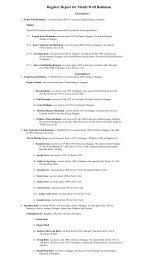
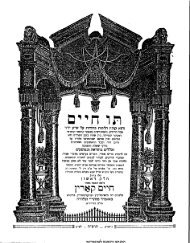
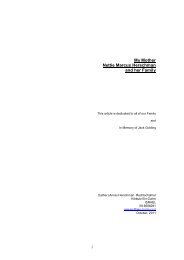
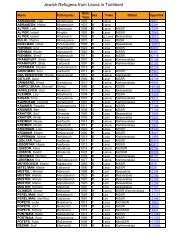
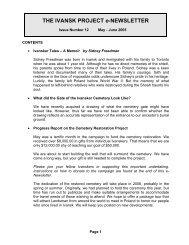
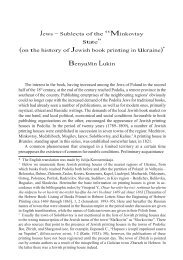
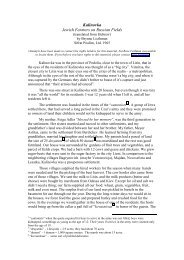
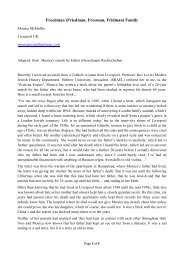
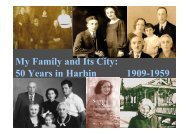
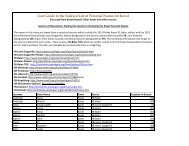


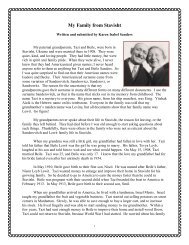
![Carta de Jaime Cesar [Negro] Lipovetzky - JewishGen KehilaLinks](https://img.yumpu.com/19183893/1/190x245/carta-de-jaime-cesar-negro-lipovetzky-jewishgen-kehilalinks.jpg?quality=85)